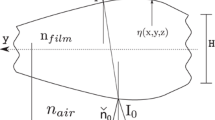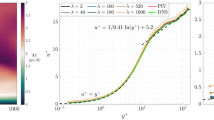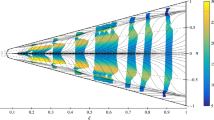Abstract
In this study, we developed a novel optical-flow algorithm for determining the wall shear-stress on the surface of objects. The algorithm solves the thin-oil-film equation using a numerical scheme that recovers local features neglected by smoothing filters. A variational formulation with a smoothness constraint was applied to extract the global shear-stress fields. The algorithm was then applied to scalar images generated using direct numerical simulation (DNS) method, which revealed that the errors were smaller than those of conventional methods. The application of the proposed algorithm to recover the wall shear-stress on a low-aspect-ratio wing and on an axisymmetric boattail model taken as examples in this study showed a strong potential for analysing shear-stress fields. Compared to the methods used in previous studies, proposed method reveals more local features of separation line and singular points on object surface.
Graphic abstract













Similar content being viewed by others
References
Wang, H.W., Huang, Z., Li, L., et al.: The research and validation of global skin friction fields measurement based on fluorescent oil film, 30th Congress of the International Council of the Aeronautical Sciences, September 25–30. Daejeon, Korea (2016)
Delery, J.: Three-dimensional separated flow topology: critical points, separation lines and vortical structures. ISTE–Wiley, London (2013)
Goldstein, R.J.: Fluid mechanics measurements. Taylor and Francis, Milton Park (1996)
Vagt, J.D., Fernholz, H.H.: Use of surface fences to measure wall shear-stress in three-dimensional boundary layers. Aero. Quart. XXIV, 87–91 (1973)
Fernholz, H.H., Janke, G.: New developments and applications of skin-friction measuring techniques. Meas. Sci. Technol. 7, 1396–1409 (1996)
Woodiga, S.A.: Global skin friction diagnostics: The Glof technique and measurements of complex separated flows. Ph.D. Thesis, Department of Mechanical and Aeronautical Engineering, Western Michigan University, USA (2013)
Maltby, R. L.: Flow visualization in wind tunnels using indicators. AGARDorgraph 70, Royal Aircraft Establishment, Bedford, England (1962)
Boorsma, K., Zhang, X., Molin, N.: Landing gear noise control using perforated fairings. Acta. Mech. Sin. 26, 159–174 (2010)
Reda, D.C., Wilder, M.C.: Shear-sensitive liquid crystal coating method applied through transparent test surfaces. AIAA J. 39(1), 195–197 (2001)
Zhao, J.S., Scholz, P., Gu, L.X.: Measurement of surface shear-stress vector distribution using shear-sensitive liquid crystal coatings. Acta. Mech. Sin. 28, 1261–1270 (2012)
Fonov, S.D., Jones, G., Crafton, J., et al.: The development of optical technique for the measurement of pressure and skin friction. Meas. Sci. Technol. 17, 1261–1268 (2006)
Liu, T., Montefort, J., Woodiga, S., Merati, P., Shen, L.: Global luminescent oil-film skin-friction meter. AIAA J. 46(2), 476–485 (2008)
Horn, B.G., Schunck, B.K.: Determining Optical Flow. Artif. Intell. 17, 185–204 (1981)
Woodiga, S.A., Liu, T.: Skin friction fields on delta wings. Exp. Fluids 47, 897–911 (2009)
Liu, T., Woodiga, S., Montefort, J.: Global skin friction diagnostics in separated flows using luminescent oil. J. Flow Vis. Image Process. 16, 19–39 (2009)
Liu, T.: Global skin friction measurements and interpretation. Prog. Aerosp. Sci. 111, 1–19 (2019)
Tran, T.H., Ambo, T., Lee, T., et al.: Effect of boattail angles on the flow pattern on an axisymmetric afterbody at low speed. Exp. Therm. Fluid Sci. 99, 324–335 (2018)
Tran, T.H., Ambo, T., Lee, T., et al.: Effect of Reynolds number on flow behavior and pressure drag of axisymmetric conical boattails in low-speed conditions. Exp. Fluids 60(36), 1–19 (2019)
Brown, J.L., Naughton, J.W.: The thin oil film equation. NASA TM 1999-208767 (1999)
Naughton, J.W., Sheplak, M.: Modern developments in shear-stress measurement. Prog. Aerosp. Sci. 38, 515–570 (2002)
Husen, N.M., Liu, T., Sullivan, J.P.: The ratioed image film thickness meter. Meas. Sci. Technol. 29, 065301 (2018)
Liu, T., Sullivan, J.P.: Luminescent oil-film skin friction meter. AIAA J. 36(8), 1460–1465 (1998)
Zillias, G.G.: Further developments of the fringe-imaging skin friction technique. NASA TM, 110425 (1996)
Naughton, J.W., Hind, M.D.: Multi-image oil-film interferometry skin friction measurements. Meas. Sci. Technol. 24, 124003 (2013)
Husen, N.M., Liu, T., Sullivan, J.P.: Luminescent oil film flow tagging skin friction meter applied to FAITH Hill. AIAA J. 56(10), 1–12 (2018)
Sagaut, P.: Large eddy simulation for incompressible flows, 3rd edn. Springer, Berlin Heidelberg (1998)
Pope, S.B.: Turbulent flows. Cambridge University Press, Cambridge (2000)
Yang, H., Zhang, X., Ran, L., et al.: Coherent structures and wavepackets in subsonic transitional turbulent jets. Acta. Mech. Sin. 33, 10–19 (2017)
Wang, C., Ge, M.: Applying resolved-scale linearly forced isotropic turbulence in rational subgrid-scale modeling. Acta. Mech. Sin. 35, 486–494 (2019)
Hossein, F., Salarian, H., Nimvari, M.E., et al.: Effect of Gurney flap on flow separation and aerodynamic performance of an airfoil under rain and icing conditions. Acta. Mech. Sin. (2020). https://doi.org/10.1007/s10409-020-00938-3
Cassisa, C., Simoens, S., Prinet, V., et al.: Subgrid scale formulation of optical flow for the study of turbulent flow. Exp. Fluid. 51, 1739–1754 (2011)
Smagorinsky, J.: General circulation experiments with the primitive equations. Mon. Weather Rev. 91(3), 99–164 (1963)
Corpetti, T., Heitz, D., Arroyo, G., et al.: Fluid experimental flow estimation based on an optical-flow scheme. Exp. Fluids. 40(1), 80–97 (2006)
Gupta, S.N., Prince, J.L.: Stochastic formulations of optical flow algorithms under variable brightness conditions. Proc. IEEE Int. Conf. Image Process. 3, 484–487 (1995)
Carlier, J., Wieneke, B.: Report 1 on production and diffusion of fluid mechanics images and data. Fluid project deliverable 1.2. European Project Fluid image analisys and description (FLUID). http://www.fluidirisa.fr 47 (2005)
Chen, X., Zille, P., Shao, L., et al.: Optical flow for incompressible turbulence motion estimation. Exp. Fluids 56(8), 1–14 (2015)
Cai, S., Memin, E., Derian, P., et al.: Motion estimation under location uncertainty for turbulent fluid flows. Exp. Fluids 59(8), 1–17 (2018)
Schmidt, B.E., Towery, C.A.Z., Hamlington, P.E., et al.: Evaluation of wavelet-based optical flow velocimetry from OH scalar fields in reacting turbulent flows, AIAA P. 2019-0270 (2019)
Baker, S., Roth, S., Scharstein, D., et al.: A database and evaluation methodology for optical flow. Int. J. Comput. Vis. 91(1), 1–31 (2011)
Mayer, N., Ilg, E., Fischer, P., et al.: What makes good synthetic training data for learning disparity and optical flow estimation? Int. J. Comput. Vis. 126, 942–960 (2018)
Ranjan, A., Hoffmann, D.T., Tzionas, D., et al.: Learning multi-human optical flow. Int. J. Comput. Vis. 128, 873–890 (2020)
Adamo, J., Diana, R.G., Wesfreid, J.E.: Spatiotemporal spectral analysis of a forced cylinder wake. Phys. Rev. E 84, 056308 (2011)
Kolmogorov, A.N.: The local structure of turbulence in incompressible viscous fluid for very large Reynolds numbers. USSR Acad. Sci. 30, 299–303 (1941)
Liu, T., Woodiga, S., Ma, T.: Skin friction topology in a region enclosed by penetrable boundary. Exp. Fluids 51, 1549–1562 (2011)
Yang, Z., Yu, H., Huang, G.P., et al.: Divergence compensatory optical flow method for blood velocimetry. J. Biol. Eng. 139, 061005 (2017)
Lee, D., Nonomura, T., Anyoji, M., et al.: Mechanisms of surface pressure distribution within a laminar separation bubble at different Reynolds numbers. Phys. Fluids 27, 023602 (2015)
Roshko, A., Thomke, G.J.: Observations on turbulent reattachment behind an axisymmetric downstream-facing step in supersonic flow. AIAA J. 4(6), 975–980 (1966)
Chen, L., Kawase, C., Nonomura, T., et al.: Dynamic surface heat transfer and re-attachment flow measurement using luminescent molecular sensors. Int. J. Heat Mass Transf. 155, 119684 (2020)
Tran, T.H., Ambo, T., Chen, L., et al.: Effect of boattail angle on pressure distribution and drag of axisymmetric afterbodies under low-speed conditions. Trans. Japan Soc. Aero. Space Sci. 62(4), 219–226 (2019)
Zhang, C.: Study of experimental technique of oil flow with emphasis on quantitative determination of the flow position parameters on the surface. NASA TT, 20341 (1988)
Squire, L.C.: The motion of a thin oil sheet under the steady boundary layer on a body. J. Fluid Mech. 11(2), 161–179 (1961)
Acknowledgements
The authors would like to thank Professor Keisuke Asai and Professor Taku Nonomura at the Department of Aerospace Engineering, Tohoku University, Sendai, Japan for their support during the experimental processes. We also would like to thank Professor Tianshu Liu at Department of Mechanical and Aerospace Engineering, Western Michigan University, Michigan, USA for his support of images dataset in numerical process. This work was supported by Le Quy Don Technical University and Duy Tan University, Hanoi, Vietnam.
Author information
Authors and Affiliations
Corresponding author
Additional information
Publisher’s Note
Springer Nature remains neutral with regard to jurisdictional claims in published maps and institutional affiliations.
Appendices
Appendix A. Effect of pressure gradient on wall shear-stress results
The current study neglects the effects of pressure gradient and gravity on the wall shear-stress. This assumption holds in principle for most results except those near the separation position, where pressure is highly variable and the wall shear-stress is close to zero. Clearly, the pressure gradient can affect the shear-stress value as well as streamline around the surface. However, for most cases of two-dimensional flow, the pressure gradient in the direction normal to the flow fields is often small and its effect on the normal flow can be neglected. The oil flow in the normal direction can be considered to follow the direction of the boundary-layer motion. In this section, the effect of pressure on the shear-stress component, which is parallel with the flow direction, is evaluated.
Experiments were conducted on a boattail model of 20º at two velocities of V∞ = 22 m/s and V∞= 45 m/s. The experimental setup for the shear-stress measurement was the same as that for the boattail model of 18º in Sect. 4.2. Additionally, the pressure on the vertical surface was measured by silicon tubes. Details of the experimental setup are available in the paper by Tran et al. [49].
Figure 13 shows the pressure distribution on the boattail surface for the different velocities. Clearly, the minimum pressure occurs near the shoulder, where the flow separated. The change in pressure leads to a high pressure gradient in this region, as shown in Fig. 14. By comparison to the case of V∞ = 22 m/s, the pressure gradient at V∞ = 45 m/s changes greatly. It should be noted that the pressure gradient at V∞ = 45 m/s is much higher for a conventional flow in subsonic conditions, ranging within the region of 102–104 Pa/m [50].
In flow measurement technique, the maximum thickness of oil film layer is often in from 30 µm to 100 µm [25]. To estimate the effect of the pressure gradient, the oil thickness of 50 µm was used in this study, which yields a constant parameter κ of κ = 2 × 10−5. The oil viscosity is µ = 0.0276 (kg/ms) and the oil density is ρ = 895 kg/m3. From Eq. (3), the wall shear-stress can be estimated as follows:
In other words, we write the wall shear-stress as the sum of \( {{\tau }}_{{{\text{w,}}s}} = {{\tau }}{}_{{{\text{w}},0}} + {{\tau }}_{{{\text{w,}}pg}} \). Here, \( {{\tau }}_{{{\text{w}},0}} = \frac{2\mu }{\kappa I}{\text{u}} \) is the shear-stress term neglecting the effect of the pressure gradient and gravity terms, and \( {{\tau }}_{{{\text{w,}}pg}} = \frac{2\kappa I}{3}\left( {\nabla p - \rho {\text{g}}} \right) \) is the shear-stress term formed by pressure gradients and gravity.
Figure 15 shows the results obtained using the two skin-friction components for different velocities. The main effect occurs near the separation position, where the pressure gradient is high and the wall shear-stress is close to zero. The effects of pressure and gravity are very small and have a negligible effect on the wall shear-stress at V∞ = 22 m/s. However, at V∞ = 45 m/s, the effect of the pressure is very high near the separation position, which causes the separation position to move forward. These results are highly consistent with previous observations by Zhang [50] and Squire [51], whereby the separation positions changed less than 5% in a region with a high pressure gradient. Clearly, the effect of pressure gradient leads to early flow separation. However, the change in the shear-stress tendency is negligible. The effect of the pressure gradient can be reduced by the use of a thinner oil layer. To obtain a more highly accurate skin-friction calculation, further experimental setups and numerical schemes should be considered.
Appendix B. Divergence-free of optical-flow velocity vectors
In this study, the optical-flow velocity vectors were considered as divergence-free parameters. However, this assumption is not always satisfied. The divergence-free optical-flow velocity can be tested by the relation between the wall shear-stress and the luminescent intensity. Specifically, the relation between the optical-flow velocity, luminescent intensity and wall shear-stress is as follows:
or
This relation can be used to determine whether the optical-flow velocity is in fact divergence-free.
To obtain the above relation, we used the data of low-aspect-ratio wing presented in Sect. 4.1. Here, the skin-friction fields and luminescent intensity is averaged in the region of x/c = 0 to 1 and y/c = − 0.15 to 0.15. Figure 16 shows the magnitude of the mean velocity, which was calculated by \( {\text{u}} = \frac{\kappa I}{2\mu }{{\tau }}_{\text{w}} , \) and the mean divergence of the velocity obtained using Eq. (B2). The results clearly show that the divergence of the velocity is sufficiently small and can be neglected in the numerical process.
Appendix C. Lagrange multipliers and sub-grid coefficient selections
Although Lagrange multipliers are very important parameters for numerical schemes, there is no criteria for their selection. These parameters are often selected based on the numerical results, which should be consisted with experimental observations and previous knowledge. Woodiga [6] showed that the skin-friction fields on a wing surface are not sensitive to the Lagrange multipliers. The problem could occur when the Lagrange multipliers are too small or too large, which could lead to some artificial features or smoothing of the flow, respectively.
To evaluate the effect of the Lagrange multipliers on the numerical results, we conducted tests on two systematic images at t1 = 0.39 s and t2 = 0.40 s, as shown in Sect. 3. In that case, the vorticity regulation coefficient is set to α2 = 0, while divergence regulation is changed from α1 = 10−4 to 104. Figure 16 shows the effect of the Lagrange multipliers on the AAE. Generally, Lagrange multipliers play as smoothing function, which has less effect on the solution than the observation term [36]. Consequently, a change in the Lagrange multipliers in the range from 1 to 100 has only a small effect on the AAE. However, the problem will occur when the Lagrange multipliers are sufficiently large, which affects the solution and leads to a high AAE (Fig. 17).
In the next step, the effect of cs and Prsgs on the solution is considered. By changing cs and Prsgs in the ranges of cs = 0.1–0.2 and Prsgs = 0.1–1, we obtained the turbulence diffusion coefficient Dt changed from 0.01 to around 0.25. Here, the smallest and highest values of Dt correspond to (cs, Prsgs)=(0.1, 1) and (cs, Prsgs)=(0.2, 0.1), respectively. Figure 18 shows the AAE as a function of Dt. The AAE at Dt= 0 (cs = 0), which corresponds to the Horn–Struck solution, is also plotted.
From these results, it is clear that AAE decreases with increases in Dt up to Dt= 0.22, which corresponds to (cs, Prsgs)=(0.19, 0.1), and then it increases again. These results strongly agree with those observed by Cassisa (2011), where the minimum AAE corresponded to Dt= 0.2. Note that the coefficient cs= 0.19 has also been used in previous studies by Chen et al. [36] on particle-image velocimetry data to recover local features.
Appendix D. Numerical scheme for extraction of optical-flow velocity vectors
To solve Eq. (12), we apply a variational formulation. The velocity vectors is denoted as u = (u, v). Equation (12) can be rewritten as follows:
The Euler–Lagrange equation for the function \( J({\bar{\text{u}}}) \) is as follows:
The application of from Eq. (D1) to Eq. (D2) yields:
To calculate the derivative, we used the following relations:
where h is the spatial step.
By applying the above relations to Eq. (D3), the velocity components at iteration p + 1 can be calculated from p using Eq. (D5):
where \( \bar{u}_{1}^{p} = \bar{u}_{xx}^{p} + \bar{v}_{xy}^{p} + 2\frac{{\bar{u}_{{}}^{p} }}{{h^{2} }} \); \( \bar{u}_{2}^{p} = \bar{u}_{yy}^{p} - \bar{v}_{xy}^{p} + 2\frac{{\bar{u}_{{}}^{p} }}{{h^{2} }} \); \( \bar{v}_{1}^{p} = \bar{v}_{yy}^{p} + \bar{u}_{xy}^{p} + 2\frac{{\bar{v}_{{}}^{p} }}{{h^{2} }} \); \( \bar{v}_{2}^{p} = \bar{v}_{xx}^{p} + \bar{u}_{xy}^{p} + 2\frac{{\bar{v}_{{}}^{p} }}{{h^{2} }} \).
This interaction is repeated until the total error \( \left( {\left\| {u^{p + 1} - u^{p} } \right\|^{2} + \left\| {v^{p + 1} - v^{p} } \right\|^{2} } \right) \) is smaller than the given error tolerance ε.
Rights and permissions
About this article
Cite this article
Tran, T.H., Chen, L. Wall shear-stress extraction by an optical flow algorithm with a sub-grid formulation. Acta Mech. Sin. 37, 65–79 (2021). https://doi.org/10.1007/s10409-020-00994-9
Received:
Revised:
Accepted:
Published:
Issue Date:
DOI: https://doi.org/10.1007/s10409-020-00994-9










